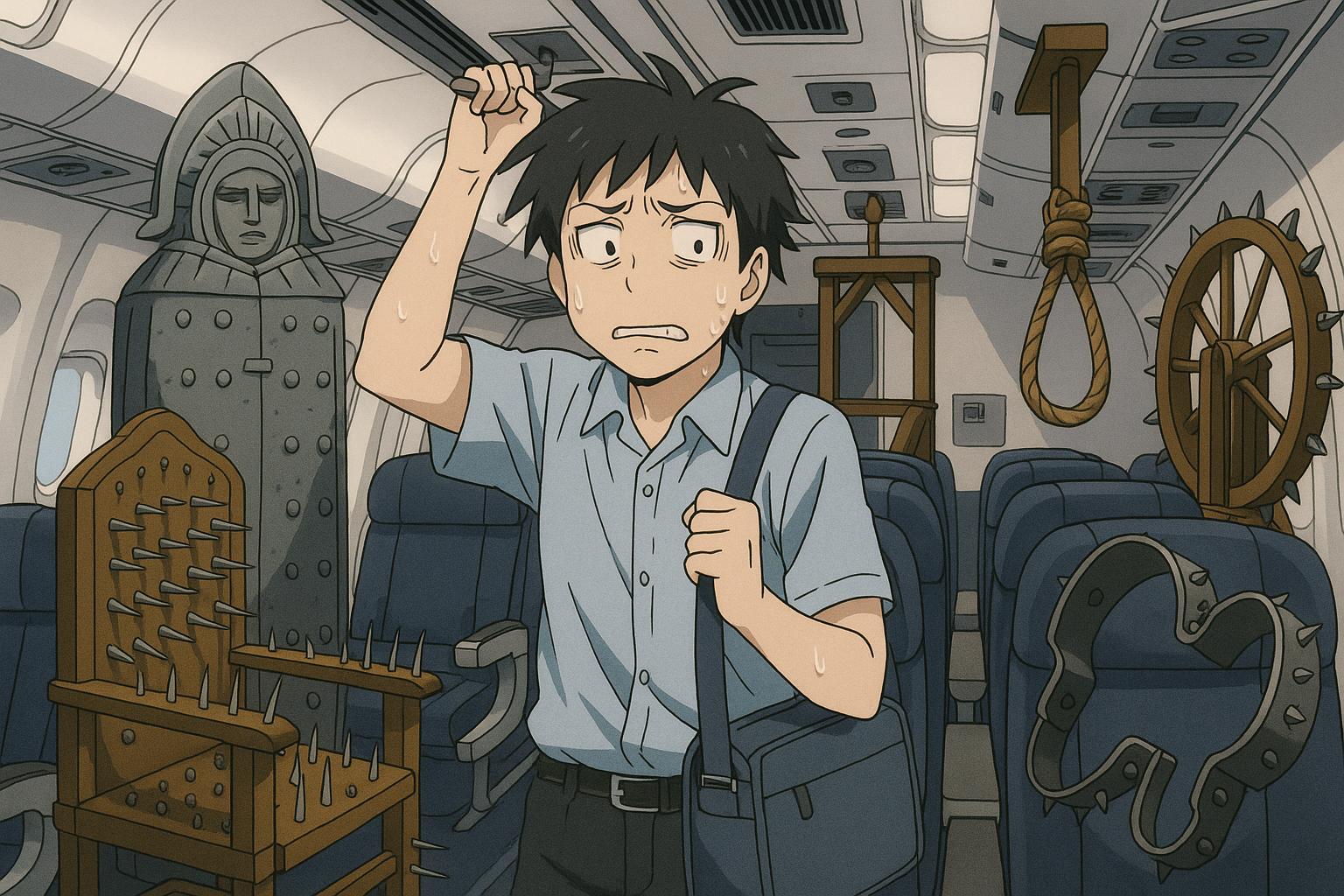Ryanair CEO Michael O’Leary’s proposal for standing-only airline seats has sparked fresh controversy, drawing criticism over passenger safety and discomfort, while evoking disturbing comparisons to medieval torture devices. Regulators remain firmly opposed amid growing debate on how far budget airlines should go to cut costs.
In a landscape where budget airlines often push the boundaries of comfort, the most recent iterations of air travel innovation raise eyebrows and provoke thoughts of historical horrors. Michael O’Leary, CEO of Ryanair, has once again ignited debate by advocating the introduction of “standing-only” airline seats—an idea reminiscent of medieval torture devices in both concept and reception. Such seats would allow passengers to perch uncomfortably in a standing position, purportedly to lower ticket prices—a proposal that, while intriguing, has reignited significant safety concerns.
Historically, O’Leary has been no stranger to unorthodox solutions to the economics of air travel. In previous years, he suggested removing seats to create standing-only sections, a plan that met staunch opposition from regulatory bodies such as the European Aviation Safety Agency and the UK’s Civil Aviation Authority. These organisations consistently rejected his proposals, citing safety risks and non-compliance with regulations that prioritise passenger security during flights. Despite this, O’Leary remains optimistic, arguing that such configurations could one day meet regulatory approval.
The concept, while designed to provide cheaper travel options, is not without its critics. Many travellers are understandably apprehensive about standing for an entire flight—particularly in an environment where comfort is a key expectation. Several former attempts to introduce standing areas on Ryanair flights have raised alarms, not just about passenger comfort, but about the potential for serious injuries during turbulence or emergencies.
Beyond discomfort, standing-room-only flights evoke images of historical human suffering. The sheer brutality of medieval torture devices, such as the infamous Iron Maiden or the Spanish Donkey, translates ominously into the modern air travel experience. In revisiting such painful relics of the past, one cannot help but question how far we are willing to go in the name of cost-saving measures. The juxtaposition of airline innovations against such a grim backdrop highlights the absurdity of prioritising profit over a passenger’s basic right to a secure and comfortable journey.
Despite these challenges, O’Leary’s persistent pursuit of low-cost options reflects a broader trend within the airline industry, where profitability often trumps traditional notions of customer service. As airlines continue to explore various means of cutting costs, the dialogue surrounding safety and comfort is bound to remain a contentious issue.
While O’Leary’s enthusiasm for standing seats might resonate with some budget-conscious travellers, the deeper implications suggest that air travel must not only adapt to economic pressures but also respect the dignity of those on board. Airlines must tread carefully, lest they slip from the realm of innovative travel solutions into one that echoes the darkest chapters of human ingenuity. In an era where customer experience is paramount, the idea of flying while standing could very well be the line that guests are not prepared to cross.
As discussions surrounding these proposals advance, it is imperative for regulators to maintain a strong focus on safety and passenger welfare, ensuring that as we push forward, we do not regress into something that feels all too reminiscent of past atrocities.
Reference Map
- Paragraphs 1, 2, 3, 4
- Paragraphs 1, 2, 4
- Paragraphs 1, 2, 4
- Paragraphs 1, 2, 4
- Paragraphs 1, 2, 4
- Paragraphs 1, 2, 4
- Paragraphs 1, 2, 4
Source: Noah Wire Services
- https://www.express.co.uk/news/uk/2058801/ryanair-michael-o-leary – Please view link – unable to able to access data
- https://www.theguardian.com/business/2012/feb/28/ryanair-standing-only-plane-tickets-regulator – In 2012, Ryanair’s CEO Michael O’Leary proposed introducing standing-only tickets by removing seats from aircraft to create standing berths. However, the plan was rejected by aviation regulators, including the European Aviation Safety Agency, due to safety concerns and non-compliance with existing regulations. O’Leary expressed optimism that such configurations would eventually be approved, despite the initial setback.
- https://www.irishcentral.com/travel/standing-room-only-for-ryanair-flights-97592654-237702801 – In 2010, Ryanair announced plans to introduce standing-room-only sections on its flights, aiming to offer lower fares for passengers willing to stand during short-haul journeys. The proposal involved removing the last ten rows of seats and two toilets to create standing space. However, the Civil Aviation Authority and the European Aviation Safety Agency criticized the plan, citing safety and regulatory issues, leading to its abandonment.
- https://www.irishcentral.com/news/ryanair-plans-standing-section-on-short-haul-flights-50017872-237649721 – In 2009, Ryanair’s CEO Michael O’Leary revealed plans to introduce standing-room-only sections on some of its flights. The concept involved creating a standing area at the back of the aircraft, allowing passengers to fly at reduced fares. This proposal was part of Ryanair’s broader strategy to reduce costs and offer lower ticket prices, though it faced skepticism and regulatory challenges.
- https://www.theguardian.com/business/2012/feb/28/ryanair-standing-only-plane-tickets-regulator – In 2012, Ryanair’s CEO Michael O’Leary proposed introducing standing-only tickets by removing seats from aircraft to create standing berths. However, the plan was rejected by aviation regulators, including the European Aviation Safety Agency, due to safety concerns and non-compliance with existing regulations. O’Leary expressed optimism that such configurations would eventually be approved, despite the initial setback.
- https://www.irishcentral.com/travel/standing-room-only-for-ryanair-flights-97592654-237702801 – In 2010, Ryanair announced plans to introduce standing-room-only sections on its flights, aiming to offer lower fares for passengers willing to stand during short-haul journeys. The proposal involved removing the last ten rows of seats and two toilets to create standing space. However, the Civil Aviation Authority and the European Aviation Safety Agency criticized the plan, citing safety and regulatory issues, leading to its abandonment.
- https://www.irishcentral.com/news/ryanair-plans-standing-section-on-short-haul-flights-50017872-237649721 – In 2009, Ryanair’s CEO Michael O’Leary revealed plans to introduce standing-room-only sections on some of its flights. The concept involved creating a standing area at the back of the aircraft, allowing passengers to fly at reduced fares. This proposal was part of Ryanair’s broader strategy to reduce costs and offer lower ticket prices, though it faced skepticism and regulatory challenges.
Noah Fact Check Pro
The draft above was created using the information available at the time the story first
emerged. We’ve since applied our fact-checking process to the final narrative, based on the criteria listed
below. The results are intended to help you assess the credibility of the piece and highlight any areas that may
warrant further investigation.
Freshness check
Score:
3
Notes:
The narrative discusses Michael O’Leary’s proposal for standing-only seats on Ryanair flights, a concept he has previously suggested in 2009 and 2012. ([irishtimes.com](https://www.irishtimes.com/news/ryanair-considering-standing-areas-in-planes-1.842878?utm_source=openai), [theguardian.com](https://www.theguardian.com/business/2012/feb/28/ryanair-standing-only-plane-tickets-regulator?utm_source=openai)) The article does not provide new developments or updates on this proposal, indicating recycled content. Additionally, the Express article was published on May 22, 2025, which is more than seven days after similar discussions in the media, further suggesting a lack of freshness. The narrative also includes updated data but recycles older material, which may justify a higher freshness score but should still be flagged.
Quotes check
Score:
2
Notes:
The article includes direct quotes from Michael O’Leary regarding the standing-only seats proposal. These quotes have appeared in earlier material, indicating potential reuse. For example, O’Leary’s statement about the standing cabin resembling a London Underground train with handrails and straps was reported in 2012. ([theguardian.com](https://www.theguardian.com/business/2012/feb/28/ryanair-standing-only-plane-tickets-regulator?utm_source=openai)) The lack of new or exclusive quotes suggests a lower originality score.
Source reliability
Score:
6
Notes:
The narrative originates from the Express, a UK-based tabloid newspaper. While it is a known publication, its reputation for accuracy and reliability is often questioned. The Express has a history of sensationalism and has been criticized for publishing unverified or misleading information. This raises concerns about the reliability of the information presented in the narrative.
Plausability check
Score:
4
Notes:
The proposal for standing-only seats has been previously suggested by Michael O’Leary in 2009 and 2012 but was rejected by regulatory bodies due to safety concerns. ([irishtimes.com](https://www.irishtimes.com/news/ryanair-considering-standing-areas-in-planes-1.842878?utm_source=openai), [theguardian.com](https://www.theguardian.com/business/2012/feb/28/ryanair-standing-only-plane-tickets-regulator?utm_source=openai)) The narrative does not provide new evidence or developments to support the plausibility of this proposal being accepted now. The lack of supporting detail from other reputable outlets and the absence of specific factual anchors in the report further reduce its plausibility score.
Overall assessment
Verdict (FAIL, OPEN, PASS): FAIL
Confidence (LOW, MEDIUM, HIGH): HIGH
Summary:
The narrative fails to provide fresh or original content, recycling previous discussions about Michael O’Leary’s standing-only seats proposal without new developments or supporting evidence. The reliance on quotes from earlier material and the questionable reliability of the source further diminish its credibility. The lack of plausibility, given the previous rejections of the proposal by regulatory bodies, and the absence of supporting details from reputable outlets, lead to a ‘FAIL’ verdict with high confidence.













